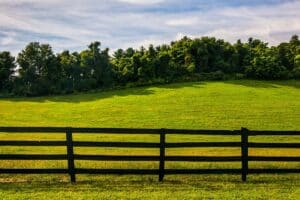Last month, I met with a young couple who had spent nearly a year searching for their perfect rural property. Their vision was clear – five acres of completely unrestricted land where they could build a small cabin, raise a few chickens, and perhaps install a tiny home for visiting family. “We just want land with no one telling us what we can and can’t do,” they explained.
After months of frustration, they’d discovered a sobering reality many land buyers eventually face: truly unrestricted land is becoming increasingly difficult to find, especially near growing communities. Their search had revealed a patchwork of limitations – from county zoning ordinances to subdivision deed restrictions, conservation easements, and even state-level regulations affecting their plans.
Their experience isn’t unique. I’m finding that many buyers begin their search with the idealized vision of finding “unrestricted land” only to discover that the concept exists on a spectrum rather than as an absolute. This realization led to a more nuanced conversation about what restrictions they could live with versus those that would fundamentally undermine their goals.
In today’s evolving land market, buyers frequently encounter this fundamental choice: restricted or unrestricted property. This decision significantly impacts both immediate usage and long-term investment potential. Understanding the implications of each option is crucial for making sound investment decisions aligned with your specific goals.
Land restrictions come in various forms – from municipal zoning ordinances to private deed restrictions, homeowners association (HOA) covenants, and conservation easements. These limitations dictate what can be built, how the property can be used, and even aesthetic elements like architectural styles. Before exploring the advantages and disadvantages, it’s important to recognize that restrictions aren’t inherently good or bad – their value depends entirely on your objectives.
The Case for Restricted Land
Restricted properties offer several compelling advantages for particular buyers. First and foremost, they provide significant value protection. In well-planned communities with thoughtful restrictions, property values tend to demonstrate greater stability and appreciation potential. These protections ensure that incompatible uses don’t diminish the value of your investment.
Consider a residential parcel in a community with architectural controls and minimum square footage requirements. While these restrictions limit certain freedoms, they also protect against scenarios where neighboring properties might otherwise be developed in ways that negatively impact your property’s value. The assurance that your neighbor won’t establish an industrial operation or construct structures incompatible with the area’s character provides meaningful security.
Additionally, restrictions often correlate with better infrastructure and amenities. Planned communities with deed restrictions typically feature more comprehensive infrastructure – from quality roads to utilities and community amenities – all contributing to quality of life and investment performance. This infrastructure coordination is difficult to achieve in completely unrestricted areas.
Financing options may also be more favorable for restricted properties. Lenders generally view well-restricted properties as lower-risk investments, potentially leading to better loan terms and lower interest rates. This financial advantage shouldn’t be overlooked when calculating the total cost of acquisition.
The Appeal of Unrestricted Land
Unrestricted properties offer compelling benefits centered around flexibility and freedom. Without the limitations imposed by HOAs or deed restrictions, owners enjoy maximum versatility in how they develop and use their property. This freedom proves particularly valuable for buyers with specific, unconventional plans that might otherwise conflict with standard restrictions.
For example, someone interested in establishing a small business on their property, keeping livestock, or building with alternative materials would find unrestricted land far more accommodating. The ability to execute your vision without navigating approval processes represents significant value for many buyers.
Unrestricted properties also typically involve lower carrying costs. Without HOA fees, architectural review expenses, or compliance costs, the ongoing financial burden is generally reduced. This advantage becomes particularly significant for long-term holdings where annual expenses meaningfully impact overall returns.
Furthermore, unrestricted land often (though not always) comes at a lower initial acquisition cost. Rural areas and less developed regions frequently offer unrestricted parcels at more accessible price points, allowing investors to acquire larger acreage for the same investment.
Neighbor Dynamics: The Reality of Unrestricted Land
Perhaps the most tangible illustration of unrestricted land dynamics emerges when examining neighboring properties with dramatically different uses. Consider a scenario increasingly common in rural areas: one landowner invests significantly in an off-grid dream home, complete with solar arrays, rainwater collection systems, and thoughtful landscaping that enhances both the property’s aesthetic appeal and its market value. Their land represents both a financial investment and a lifestyle choice, with careful development decisions increasing the property’s worth substantially.
Meanwhile, on an adjacent unrestricted parcel, another owner has chosen to use their land as an informal storage yard for non-operational vehicles, discarded appliances, and used tires. Without restrictions preventing such use, this owner exercises their property rights in a way that serves their immediate needs – perhaps supporting a salvage business or simply providing free storage for unwanted items.
This juxtaposition creates a complex dynamic where unrestricted land works to the advantage of one owner while potentially disadvantageous to another. For the junkyard operator, unrestricted land represents essential freedom to use their property productively according to their specific needs without bureaucratic oversight or compliance costs. The absence of restrictions enables a use that might be economically beneficial to them but would be prohibited in most restricted communities.
Conversely, the off-grid homeowner may find their substantial investment undermined by neighboring uses that affect both their quality of life and property value. Research consistently demonstrates that incompatible adjacent uses can reduce residential property values by 15-30% – a significant financial impact that no investor can afford to ignore.
The tension between these competing interests highlights a fundamental truth about unrestricted land: its value proposition changes dramatically depending on your position in the neighborhood ecosystem. For those seeking maximum freedom in their own land use – whether for agricultural operations, small businesses, alternative building methods, or other non-standard uses – unrestricted land offers irreplaceable advantages. The ability to execute your vision without oversight or approval processes represents substantial value.
However, this same freedom extended to neighboring properties creates vulnerability that restricted communities specifically aim to prevent. Without reciprocal protections, the actions of adjacent landowners can significantly impact your enjoyment and investment performance. This vulnerability explains why many buyers intentionally seek properties with at least basic restrictions against clearly detrimental uses, even while avoiding the more controlling regulations of typical suburban developments.
When evaluating unrestricted land, savvy investors carefully assess not just current neighboring uses but the potential for future changes. An unrestricted parcel surrounded by well-maintained properties with similar uses presents a substantially different risk profile than one adjacent to parcels with unpredictable future development patterns. This neighbor assessment becomes an essential component of due diligence when considering unrestricted land investments.
Drawbacks to Consider
Restricted properties come with notable disadvantages. The limitations on use can substantially impair flexibility, potentially preventing owners from adapting to changing conditions or personal needs. Restrictions that once seemed reasonable might become problematic as circumstances evolve.
The financial burden of compliance shouldn’t be underestimated either. Beyond HOA fees, architectural review costs, and assessments, restricted properties often require ongoing investments to maintain compliance with community standards. These expenses can significantly impact overall returns.
Additionally, governance challenges can emerge in restricted communities. Dealing with HOA boards, architectural committees, and sometimes challenging neighbors can create administrative burdens that many property owners find frustrating and time-consuming.
Conversely, unrestricted properties present their own set of challenges. Perhaps most significantly, they offer limited protection against neighboring uses that might adversely affect value. Without restrictions, adjacent property owners maintain the freedom to use their land in ways that could negatively impact your investment – from starting incompatible businesses to maintaining properties below community standards.
Infrastructure in unrestricted areas is typically less developed and coordinated. Roads, utilities, and services may receive less consistent attention, potentially requiring significant private investment to establish and maintain. This infrastructure deficit can substantially impact both quality of life and property values.
From an investment perspective, unrestricted properties sometimes exhibit greater market volatility. Without the stabilizing influence of community standards and coordinated development, values may fluctuate more dramatically in response to market conditions or changes in surrounding properties.
Finding the Right Balance
Many buyers find that moderate restrictions offer an optimal middle ground. Properties with basic protections against clearly detrimental uses, but without micromanagement of aesthetic choices and personal activities, often provide a reasonable balance of protection and freedom.
Conservation easements represent another thoughtful compromise. These legal agreements protect environmental assets while potentially providing tax benefits and preserving core property rights. For conservation-minded investors, these arrangements can offer meaningful protection while maintaining essential freedoms.
Making Your Decision
When evaluating restricted versus unrestricted land, consider these critical factors:
- Investment Timeframe: Longer holds might benefit from the stability of reasonable restrictions, while shorter-term investments might prioritize flexibility.
- Primary Purpose: Your intended use should drive the decision. Building a primary residence might favor reasonable restrictions, while diverse agricultural or business uses might require unrestricted land.
- Risk Tolerance: Unrestricted properties generally involve greater variability in outcomes, requiring higher risk tolerance.
- Surrounding Context: Evaluate the existing pattern of development. An unrestricted property surrounded by well-maintained properties presents different considerations than one in a completely unregulated area.
- Future Marketability: Consider who will want your property when it’s time to sell. Restrictions that align with market preferences can enhance future liquidity.
The restricted versus unrestricted decision ultimately depends on your specific objectives, risk tolerance, and vision for the property. By carefully evaluating your priorities and thoroughly investigating specific restrictions, you can identify the option that best aligns with your investment goals and personal preferences.
This content may not be used or reproduced in any manner whatsoever, in part or in whole, without written permission of LANDTHINK. Use of this content without permission is a violation of federal copyright law. The articles, posts, comments, opinions and information provided by LANDTHINK are for informational and research purposes only and DOES NOT substitute or coincide with the advice of an attorney, accountant, real estate broker or any other licensed real estate professional. LANDTHINK strongly advises visitors and readers to seek their own professional guidance and advice related to buying, investing in or selling real estate.










Add Comment